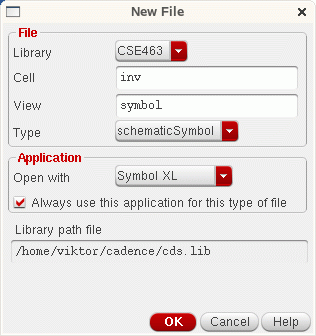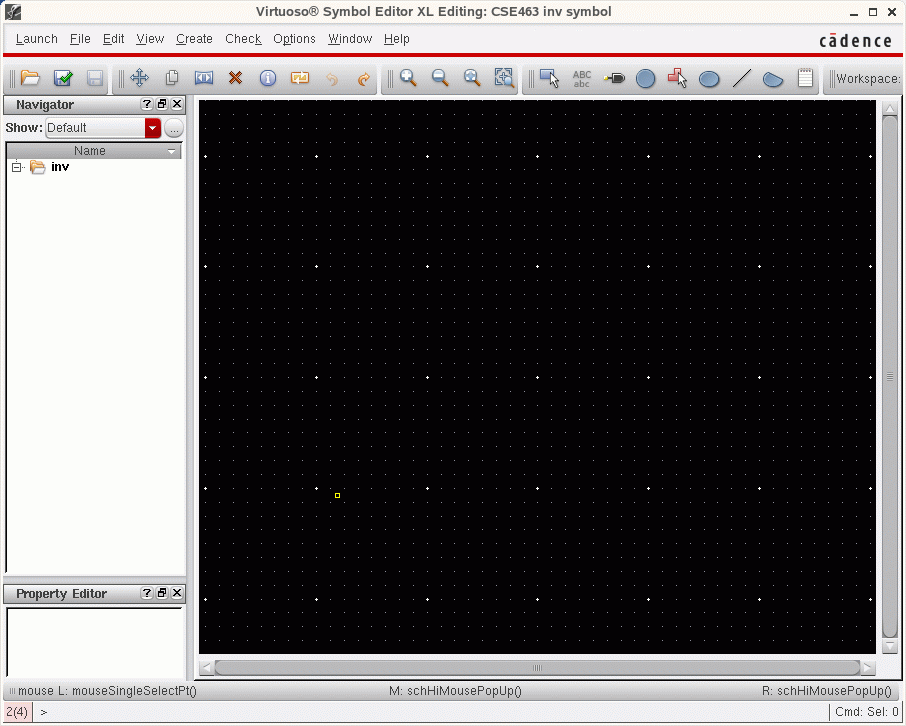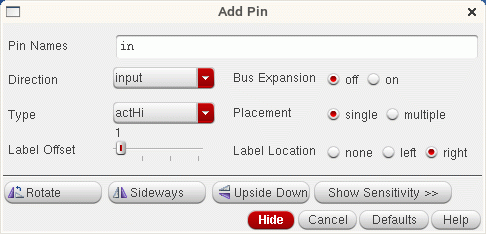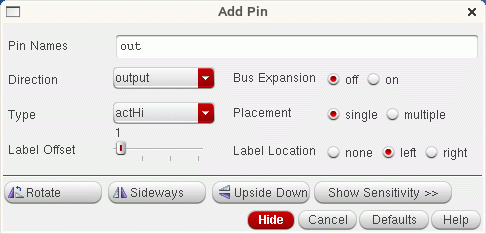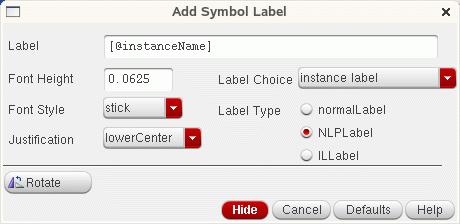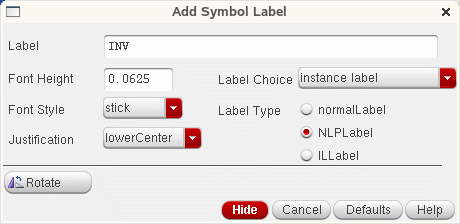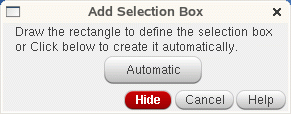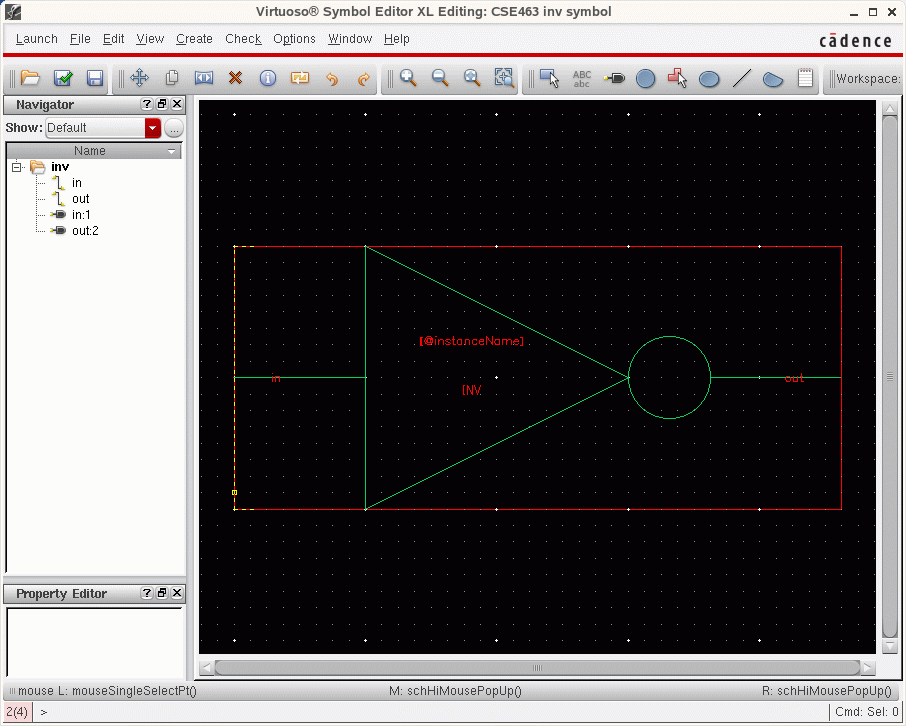Difference between revisions of "Tutorials:Cadence:CreatingSymbolInverter"
| Line 64: | Line 64: | ||
: [[File:Tutorials-Cadence-Symbol_Complete.gif]] | : [[File:Tutorials-Cadence-Symbol_Complete.gif]] | ||
| + | |||
| + | |||
| + | [[Tutorials:Cadence:PrintSchematic|Prev]] : [[Tutorials:Cadence:SchematicSimulationDCAnalysis|Next]] : [[Tutorials:Cadence:Main|Up]] | ||
---- | ---- | ||
{{Template:CadenceDisclaimer}} | {{Template:CadenceDisclaimer}} | ||
Revision as of 17:12, 10 November 2010
Creating Symbols: Inverter Symbol
The symbol editor lets you create a "black box" description of a cell using labels, pins, shapes, notes, and a selection box. Symbols make your design more readable, as you can use them in more complex designs, instead of individual transistors.
In the Library Manager click once on the CSE463 library. Then left click Library Manager:File → New Cell. In the Cell Name type inv and in the View Name box type symbol. You can also click on the Tool box and select Composer → Symbol and the View Name box will be automatically filled.
Left click OK
The Virtuoso Symbol Editing window like the one below should appear.
You are ready to draw a symbol for the inverter. First, we will draw a triangle to represent the inverter body. Left click Editing: Add → Shape → Polygon
The Add Symbol Shape window appears. Left click Hide for now. To draw a polygon, click at a start point, and then click at the corners of the shape you want to create. To finish the polygon, click again on the start point. Since we are drawing an inverter, we need a sideways triangle, so make one of those. Look at the final picture at the bottom for guidance to draw.
The inverter needs a negation circle at the sideways corner of the triangle, so left click Editing:Add → Shape → Circle. Hide the Add Symbol window again. Left click at the point you want to be the center of the circle. Move the mouse until the circle is the size you want, and left click again.
Now draw a line that starts at the middle of the vertical line of the triangle and ends somewhere to it's left and another line from the rightmost part of the circle to somewhere equally to the right, so left click Editing:Add → Shape → Line.
Hint: Rather than invoking the Add Symbol Shape box every time and having to go through the menus, you can use the shortcut buttons located on the left side of the window.
Now, you want to add pins to the symbol. Left click Editing:Add → Pin
In the Pin Names box type the following pin names: in. Also change the direction of the pins to Input for in and Output for out.
You are going to start placing the pins in the symbol. The pin looks a little different than the ones in the schematic, so be careful. You will notice that it is a box with a line attached. The end of the line will have the pin name. The box is the actual pin, so it must point AWAY from the rest of the symbol.
Add the in pin on the left of the symbol. The pins in ALL cell views of a single cell must have the same attributes and names. In other words, if the type of the pin is input in the schematic, it should be input type in the symbol also. When you save your symbol, any differences between the pins of the symbol and the pins of the schematic will be reported as warnings. Following these warnings you can figure out where the inconsistency in the design has occurred.
Repeat the same procedure for the out pin. The Add Pin selection box should look like the one bellow:
Add the out pin on the right of the symbol.
Once you place the pins, the pin names may be hard to read for a variety of reasons. You can therefore move the pin name by clicking on the pin text label and then left click on Editing:Edit → Move. Now you can move the label and place where ever you want to. Next we want to add label to the symbol. Left click Editing: Add → Label... The Add Symbol Label dialog box should appear.
We will add an instance label. Just left click the Hide button, and place the label somewhere near the symbol of the inverter.
Later, when you use symbols to build schematic, the software needs to know which symbol is which. It does this by looking at the instance label to see which one of those it is. If you put multiple symbols into a schematic window, they will be labeled U1, U2, etc.
Next, we will add a label to the symbol which will describe the circuitry. In this case, the label will be INV for inverter. In the Add Label window type INV in the Label field as shown in the figure below:
We will add the label in the symbol. Just left click the Hide button, and place the label somewhere near the symbol of the inverter.
The last thing to add is a selection box. This will tell the software how much of the symbol is actually used.
Left click Editing: Add → Selection Box...
Left click the Automatic button.
The symbol is now finish and you can save it by left clicking Editing:Design → Save. The symbol should look like the one below.
Information is provided "as is" without warranty or guarantee of any kind. No statement is made and no attempt has been made to examine the information, either with respect to operability, origin, authorship, or otherwise.
Please use this information at your own risk--and any attempt to use this information is at your own risk--we recommend using it on a copy of your data to be sure you understand what it does and under what conditions. Keep your master intact until you are personally satisfied with the use of this information within your environment."
Cadence® is a trademark of Cadence Design Systems, Inc., 555 River Oaks Parkway, San Jose, CA 95134
For web related questions contact: Viktor Gruev, Michael Hall
